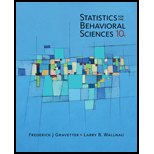
Concept explainers
4. Problems 5 and 6 in Chapter 17 cited a study showing that people tend to choose partners who are similar to themselves. Jones, Pelham, Carvallo and Mirenberg, (2004) demonstrated that people have a tendency to select marriage partners with surnames that begin with the same last letter as their own. The probability of randomly matching two last name beginning with the same letter is only p= 0.065 (6.5%)
a. If 19 out of 200 marriages involved brides and grooms with last names beginning with the same letter, is that enough to be significantly different than would be expected by chance? Use a two-tailed test with a = .05.
b. If 38 out of 400 marriages involved the same letter, is that enough to be significant using a two-tailed test with a = .05?
5. Research has demonstrated that people tend to be attracted to other who are similar to themselves. One study demonstrated that individuals are disproportionately more likely to marry those with surnames that begin with the same last letter as their own (Jones, Pelham, Carvallo, & Mirenberg 2004). The researchers began by looking at marriage records and recording the surname for each groom and the maiden name of each bride. From these record it is possible to calculate the probability of randomly matching a bride and a groom whose last names begin with the same letter. Suppose that this probability is only 6.5%. Next, a sample of n=200 married couples is selected and the number who shared the same last initial at the time they were married is counted. The resulting observed frequencies are as follows:
Same Initial IDifferent
Initials
19 181 200
Do these date indicate that the number of couples with the same last initial is significantly different that would be expected if couples were matched ran domly? Test with a = .05.
6.Suppose that the researcher from the previous problem repeated the study of married couples’ initials using twice as many participants and obtaining observed frequencies that exactly double the original values. The resulting data are as follows:
Same
Initial
Different Initials
38 362 400
- Use a chi-square test to determine whether the number of couples with the last initial is significantly different that would be expected if couple were matched randomly. Test with a = .05.
- You should find that the data lead to rejecting the null hypothesis. However, in problem 5 the decision was fail to reject. How do you explain the fact that the two samples have the same proportions but lead to different conclusion?
Trending nowThis is a popular solution!

Chapter 18 Solutions
Statistics for the Behavioral Sciences, Loose-leaf Version
 Glencoe Algebra 1, Student Edition, 9780079039897...AlgebraISBN:9780079039897Author:CarterPublisher:McGraw Hill
Glencoe Algebra 1, Student Edition, 9780079039897...AlgebraISBN:9780079039897Author:CarterPublisher:McGraw Hill
